|
Strain Name
|
C57BL/6-Pdcd1tm1(PDCD1)Bcgen Cd276tm1(CD276)Bcgen/Bcgen
|
Common Name
|
B-hPD-1/hB7-H3 mice
|
|
Background
|
C57BL/6
|
Catalog number
|
121152
|
Related Genes
|
PD-1, PDCD1, 4Ig-B7-H3, B7-H3, B7H3, B7RP-2
|
NCBI Gene ID
|
18566,102657
|
Protein expression analysis in T cells
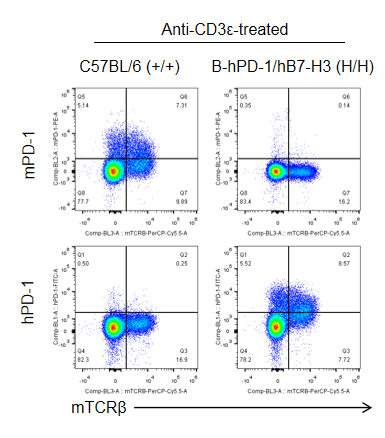
Strain specific PD-1 expression analysis in homozygous B-hPD-1/hB7-H3 (H/H) mice by flow cytometry. Splenocytes were collected from WT and homozygous B-hPD-1/hB7-H3 (H/H) mice stimulated with anti-CD3ε in vivo, and analyzed by flow cytometry with species-specific anti-PD-1 antibody. Mouse PD-1 was detectable in WT mice. Human PD-1 was exclusively detectable in homozygous B-hPD-1/hB7-H3 but not WT mice.
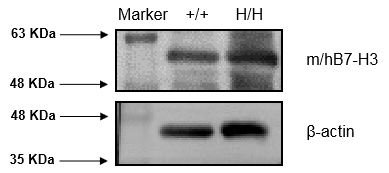
Strain specific analysis of B7-H3 expression in WT and B-hPD-1/hB7-H3 mice by western blot. Epididymis were collected from WT (+/+) mice and homozygous B-hPD-1/hB7-H3 mice. Mouse B7-H3 was detectable in WT mice. Human B7-H3 was detectable in the epididymis of B-hPD-1/hB7-H3 mice due to the cross-reactivity of antibodies.
Analysis of spleen leukocyte subpopulations in B-hPD-1/hB7-H3 mice
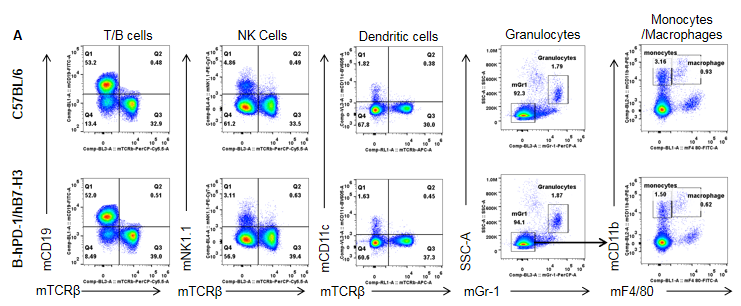
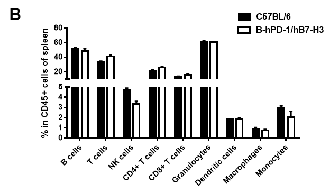
Analysis of splenic leukocyte subpopulations by FACS. Splenocytes were isolated from female C57BL/6 and B-hPD-1/hB7-H3 mice (n=3, 6 weeks-old) and analyzed by flow cytometry to assess leukocyte subpopulations. (A) Representative FACS plots gated on single live CD45+ cells for further analysis. (B) Results of FACS analysis. Percentages of T, B, NK cells, monocytes/macrophages, and DC were similar in homozygous B-hPD-1/hB7-H3 mice and C57BL/6 mice, demonstrating that introduction of hPD-1/hB7-H3 in place of its mouse counterpart does not change the overall development, differentiation, or distribution of these cell types in spleen. Values are expressed as mean ± SEM.
Analysis of spleen leukocyte subpopulations in B-hPD-1/hB7-H3 mice
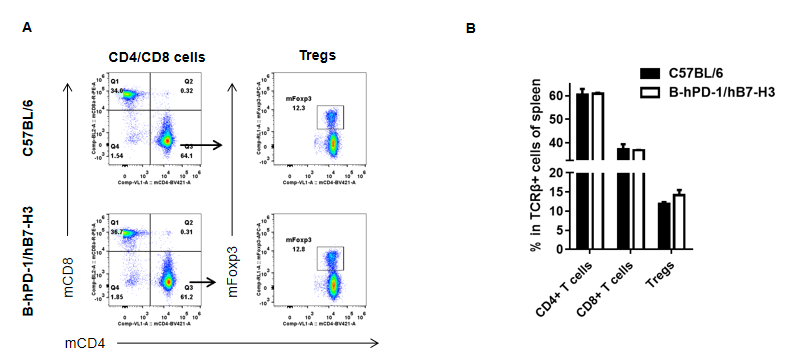
Analysis of splenic T cell subpopulations by FACS. Splenocytes were isolated from female C57BL/6 and B-hPD-1/hB7-H3 mice (n=3, 6 weeks-old) and analyzed by flow cytometry for T cell subsets. (A) Representative FACS plots gated on TCRβ+ T cells and further analyzed. (B) Results of FACS analysis. Percentages of CD8+, CD4+, and Treg cells were similar in homozygous B-hPD-1/hB7-H3 and C57BL/6 mice, demonstrating that introduction of hPD-1/hB7-H3 in place of its mouse counterpart does not change the overall development, differentiation or distribution of these T cell subtypes in spleen. Values are expressed as mean ± SEM.
Analysis of blood leukocyte subpopulations in B-hPD-1/hB7-H3 mice
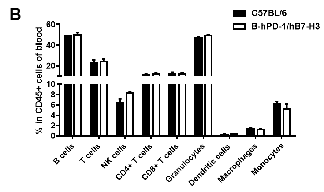
Analysis of blood leukocyte subpopulations by FACS. Blood were isolated from female C57BL/6 and B-hPD-1/hB7-H3 mice (n=3, 6 weeks-old) and analyzed by flow cytometry to assess leukocyte subpopulations. (A) Representative FACS plots gated on single live CD45+ cells for further analysis. (B) Results of FACS analysis. Percentages of T, B, NK cells, monocytes/macrophages, and DC were similar in homozygous B-hPD-1/hB7-H3 mice and C57BL/6 mice, demonstrating that introduction of hPD-1/hB7-H3 in place of its mouse counterpart does not change the overall development, differentiation, or distribution of these cell types in blood. Values are expressed as mean ± SEM.
Analysis of blood leukocyte subpopulations in B-hPD-1/hB7-H3 mice
Analysis of blood T cell subpopulations by FACS. Blood were isolated from female C57BL/6 and B-hPD-1/hB7-H3 mice (n=3, 6 weeks-old) and analyzed by flow cytometry for T cell subsets. (A) Representative FACS plots gated on TCRβ+ T cells and further analyzed. (B) Results of FACS analysis. Percentages of CD8+, CD4+, and Treg cells were similar in homozygous B-hPD-1/hB7-H3 and C57BL/6 mice, demonstrating that introduction of hPD-1/hB7-H3 in place of its mouse counterpart does not change the overall development, differentiation or distribution of these T cell subtypes in blood. Values are expressed as mean ± SEM.
Combination therapy of anti-human PD-1 antibody and anti-human B7-H3 antibody

Antitumor activity of Tislelizumab combined with Enoblituzumab in B-hPD-1/hB7-H3 mice. (A) Anti-human PD-1 antibody Tislelizumab combined with anti-human B7-H3 antibody Enoblituzumab (both of the antibodies were produced in house) inhibited B-CAG-hB7-H3 EL4 cells tumor growth in B-hPD-1/hB7-H3 mice. B-CAG-hB7-H3 EL4 cells were subcutaneously implanted into homozygous B-hPD-1/hB7-H3 mice (female, 6-8 week-old, n=6). Mice were grouped when tumor volume reached approximately 90-100 mm3, at which time they were treated with hPD-1 and hB7-H3 antibodies. (B) Body weight changes during treatment. As shown in panel A, combination of hPD-1 and hB7-H3 antibodies were more efficacious in controlling tumor growth in B-hPD-1/hB7-H3 mice. B-hPD-1/hB7-H3 mice provide a powerful preclinical model for in vivo evaluation of anti-human PD-1 and B7-H3 antibodies. Values are expressed as mean ± SEM.





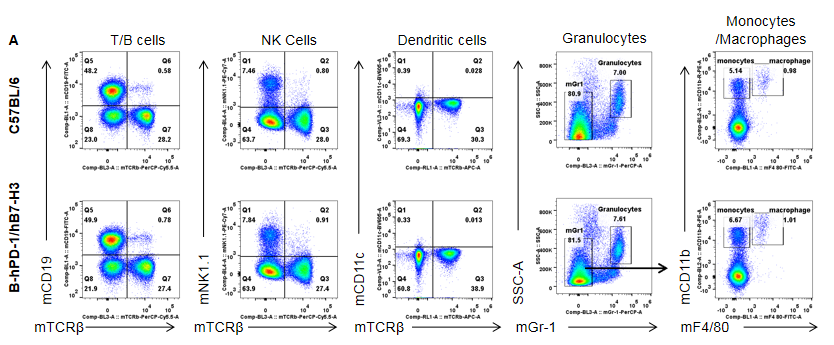

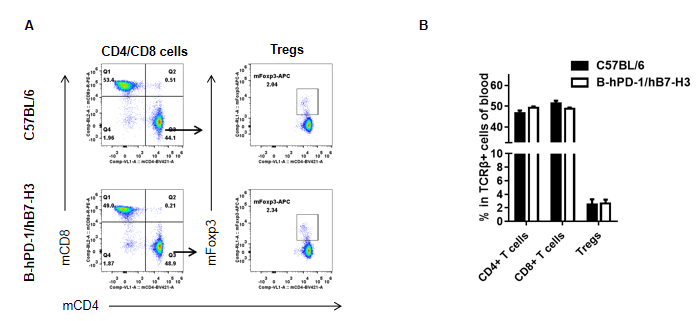













 京公网安备:
京公网安备: